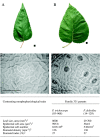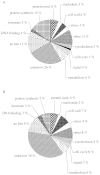Populus: arabidopsis for forestry. Do we need a model tree?
- PMID: 12451023
- PMCID: PMC4240366
- DOI: 10.1093/aob/mcf255
Populus: arabidopsis for forestry. Do we need a model tree?
Abstract
Trees are used to produce a variety of wood-based products including timber, pulp and paper. More recently, their use as a source of renewable energy has also been highlighted, as has their value for carbon mitigation within the Kyoto Protocol. Relative to food crops, the domestication of trees has only just begun; the long generation time and complex nature of juvenile and mature growth forms are contributory factors. To accelerate domestication, and to understand further some of the unique processes that occur in woody plants such as dormancy and secondary wood formation, a 'model' tree is needed. Here it is argued that Populus is rapidly becoming accepted as the 'model' woody plant and that such a 'model' tree is necessary to complement the genetic resource being developed in arabidopsis. The genus Populus (poplars, cottonwoods and aspens) contains approx. 30 species of woody plant, all found in the Northern hemisphere and exhibiting some of the fastest growth rates observed in temperate trees. Populus is fulfilling the 'model' role for a number of reasons. First, and most important, is the very recent commitment to sequence the Populus genome, a project initiated in February 2002. This will be the first woody plant to be sequenced. Other reasons include the relatively small genome size (450-550 Mbp) of Populus, the large number of molecular genetic maps and the ease of genetic transformation. Populus may also be propagated vegetatively, making mapping populations immortal and facilitating the production of large amounts of clonal material for experimentation. Hybridization occurs routinely and, in these respects, Populus has many similarities to arabidopsis. However, Populus also differs from arabidopsis in many respects, including being dioecious, which makes selfing and back-cross manipulations impossible. The long time-to-flower is also a limitation, whilst physiological and biochemical experiments are more readily conducted in Populus compared with the small-statured arabidopsis. Recent advances in the development of large expressed sequence tagged collections, microarray analysis and the free distribution of mapping pedigrees for quantitative trait loci analysis secure Populus as the ideal subject for further exploitation by a wide range of scientists including breeders, physiologists, biochemists and molecular biologists. In addition, and in contrast to other model plants, the genus Populus also has genuine commercial value as a tree for timber, plywood, pulp and paper.
Copyright 2002 Annals of Botany Company
Figures



Similar articles
-
Analysis of 4,664 high-quality sequence-finished poplar full-length cDNA clones and their utility for the discovery of genes responding to insect feeding.BMC Genomics. 2008 Jan 29;9:57. doi: 10.1186/1471-2164-9-57. BMC Genomics. 2008. PMID: 18230180 Free PMC article.
-
Induced somatic sector analysis of cellulose synthase (CesA) promoter regions in woody stem tissues.Planta. 2013 Mar;237(3):799-812. doi: 10.1007/s00425-012-1792-x. Epub 2012 Nov 7. Planta. 2013. PMID: 23132521
-
A genomic approach to investigate developmental cell death in woody tissues of Populus trees.Genome Biol. 2005;6(4):R34. doi: 10.1186/gb-2005-6-4-r34. Epub 2005 Mar 22. Genome Biol. 2005. PMID: 15833121 Free PMC article.
-
Arabidopsis thaliana full genome longmer microarrays: a powerful gene discovery tool for agriculture and forestry.Transgenic Res. 2005 Oct;14(5):551-61. doi: 10.1007/s11248-005-8926-x. Transgenic Res. 2005. PMID: 16245146 Review.
-
Modeling transcriptional networks regulating secondary growth and wood formation in forest trees.Physiol Plant. 2014 Jun;151(2):156-63. doi: 10.1111/ppl.12113. Epub 2013 Oct 21. Physiol Plant. 2014. PMID: 24117954 Review.
Cited by
-
Host plant genetic control of associated fungal and insect species in a Populus hybrid cross.Ecol Evol. 2020 Apr 27;10(11):5119-5134. doi: 10.1002/ece3.6266. eCollection 2020 Jun. Ecol Evol. 2020. PMID: 32551087 Free PMC article.
-
Biotechnological Potential of the Stress Response and Plant Cell Death Regulators Proteins in the Biofuel Industry.Cells. 2023 Aug 8;12(16):2018. doi: 10.3390/cells12162018. Cells. 2023. PMID: 37626829 Free PMC article.
-
Identification and expression of CAMTA genes in Populus trichocarpa under biotic and abiotic stress.Sci Rep. 2017 Dec 20;7(1):17910. doi: 10.1038/s41598-017-18219-8. Sci Rep. 2017. PMID: 29263356 Free PMC article.
-
CRISPR/Cas9 Gene Editing: An Unexplored Frontier for Forest Pathology.Front Plant Sci. 2020 Jul 22;11:1126. doi: 10.3389/fpls.2020.01126. eCollection 2020. Front Plant Sci. 2020. PMID: 32793272 Free PMC article. Review.
-
Evaluation of qPCR reference genes in two genotypes of Populus for use in photoperiod and low-temperature studies.BMC Res Notes. 2012 Jul 23;5:366. doi: 10.1186/1756-0500-5-366. BMC Res Notes. 2012. PMID: 22824181 Free PMC article.
References
-
- AGI.2000. Arabidopsis thaliana genome. Nature 408: 791–826. - PubMed
-
- Alonso‐BlancoC, Koornneef M.2000. Naturally occurring variation in Arabidopsis: an underexploited resource for plant genetics. Trends in Plant Science 5: 22–29. - PubMed
-
- BaucherM, Monties B, Van Montagu M, Boerjan W.1998. Biosynthesis and genetic engineering of lignin. Critical Reviews in Plant Sciences 17: 125–197.
Publication types
MeSH terms
LinkOut - more resources
Full Text Sources
Other Literature Sources
Miscellaneous

